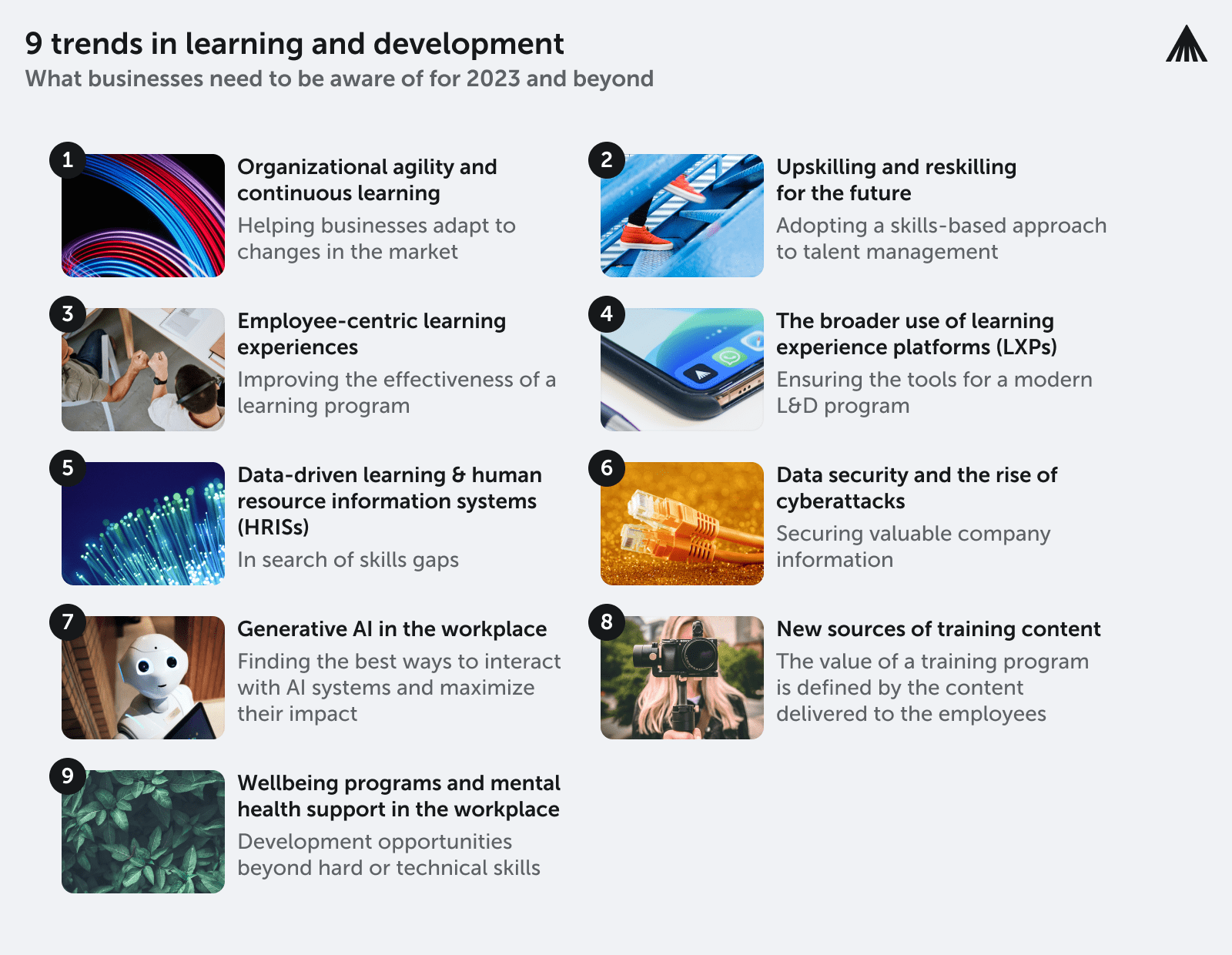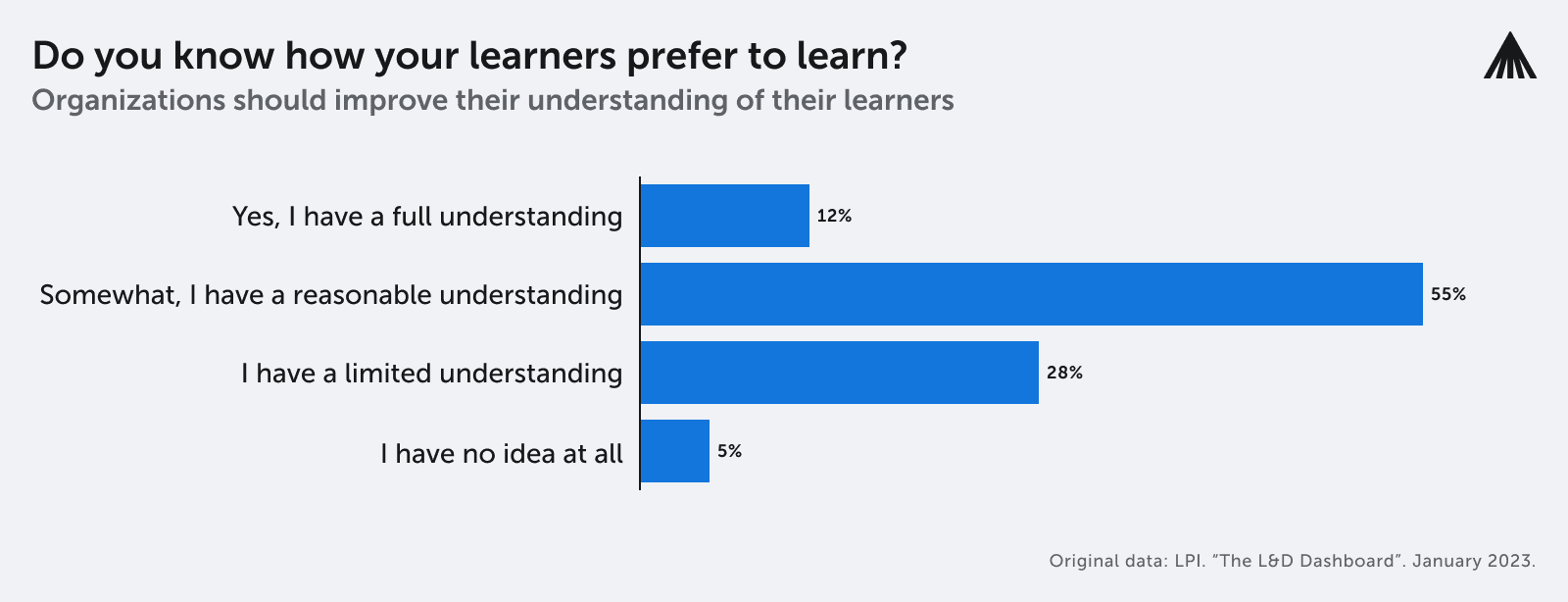Trends in employee learning and development 2024-2025: future-ready workforce
Get ahead with innovative strategies and technologies. Discover the 2024-2025 (updated) trends that are shaping the future of workforce skills.

Comments from Rob on the update for the 2024-2025 L&D trends, a year after publishing this blog:
Last year we wrote the below article to highlight what’s the current trends are in L&D. In general much has not changed and the key topics maintain their prevalence in our discussions with customers and industry experts but there has clearly been one undeniable change.
When we outlined our trends for 2023 ChatGPT was only just released and many professionals had not tested or used its functionality. In May 2024 it is by far the most common topic discussed in new sales calls and also common among our existing customers.
We have seen a wide-range of adoption across our customers, from one large enterprise partnering with ChatGPT to run an internal engine across much of the intranet to another legal firm unable to adopt any AI technology until stringent internal security reviews have been conducted.
It is clear that there is no one-size fits all approach and organisations will learn their way through their own strategy based on their L&D maturity but also their businesses appetite for disruption and risk.
The landscape of training and development is perpetually evolving to accommodate the requirements of organizations and their employees. Amid the recent upheaval in the business world, this evolution has begun to resemble a revolution.
Note: This blog is regularly updated to reflect the latest information and trends. All new updates (where it is applicable) and revisions are added to this blog post.
LinkedIn’s 2023 Workplace Learning report revealed that the required skillsets for modern work have changed by 25% since 2015, and this figure is expected to double by 2027. Coupled with recent findings that indicate 77% of employers are struggling to fill roles, (a 17-year high), the need to offer impactful reskilling and onboarding programs are more important than ever.
As new technologies are released and adopted it increases the need for solid foundational training. If you asked me what a ‘prompt engineer’ was last year, I wouldn’t have been able to say what it does or what skills are necessary to excel within that role.
In such a climate, companies boasting comprehensive and adaptable employee training and development programs are best equipped for success. With fewer external talents entering businesses and the nature of work adapting to align with novel digital strategies, the competitive advantage derived from cultivating employees internally is only expanding.
However, maintaining that ability requires constant work and an understanding of the new trends affecting the field.
Key learning and development trends
Listed below are learning and development trends every business needs to be aware of for 2023 and beyond.

1. Organizational agility and continuous learning
Turmoil in the business world means more and more companies are focusing on organizational agility and the ability to adapt to changes in the market quickly. A recent survey from Deloitte shows 85% of business executives want more agile ways of organizing work.
Improving organizational agility requires continuous learning, empowering employees to rapidly comprehend new situations and respond effectively.
Update (2024): This has continued, reinforcing the foundations of many L&D programs to be stronger and more data- and compliance-backed. Additionally, there has been a concerted effort to build core competencies.
L&D teams can pave the way by providing fresh educational opportunities and maintaining current training materials that reflect both the organization’s immediate needs and broader market conditions.
Embracing organizational agility yields mutual benefits for companies and their employees. While the organization acquires the competencies necessary to thrive and expand during challenging market circumstances, employees gain access to training opportunities and the acquisition of new skills that can bolster their future career prospects.
Read: How to Create an Effective Learning and Development (L&D) Strategy
2. Upskilling and reskilling for the future
Given the ever-changing demands of the modern workforce, it is unsurprising that upskilling and reskilling remain a priority for organizations across the board.
According to LinkedIn, 89% of L&D professionals believe proactively developing employee skills enables organizations to better navigate the future of work. Some of the most sought-after skills include
- Management
- Communication
- Customer service
- Leadership
We are starting to see an increasing number of businesses adopting a skills-based approach to talent management. This strategy emphasizes skills over roles, ensuring employees possess the cutting-edge competencies needed for success.
Moreover, organizations are beginning to apply product development best practices more broadly, establishing project teams focused on task execution rather than adhering to traditional business unit and department structures.
The enthusiasm for retraining and learning new skills is matched by most employees. PWC’s workforce of the future report found 74% of workers want to develop their skills to remain employable.
Organizations can further enhance their skill-building initiatives by implementing recognition or incentive programs that reward employees for their participation.
Update (2024): However, progress has not been as advanced as anticipated over the past 18 months. Many organizations still face challenges in rolling out skills frameworks and often require external assistance. Additionally, the rollout of AI has disrupted several skill strategies, as AI can handle many menial tasks, reducing the need to train employees for basic functions.

How to conduct a skills gap analysis and what to do next
Start building your foundation for strategic workforce development.
Download guide3. Employee-centric learning experiences
The overall outcome of an organization’s L&D initiatives hinges on the collective success of individual employee learning experiences. By centering on employees and optimizing each experience, businesses can enhance the efficacy of their training programs and edge closer to their objectives.
This is the core principle of an employee-centric learning culture—fostering individual success to drive organizational growth. Businesses can examine the entire training lifecycle for each employee, from onboarding to exit, with the aim of maximizing their learning experience.
Read: How to Build a Learning Culture in 10 Steps
While the concept of a Growth Mindset is prevalent in L&D, many can also benefit from ‘Growth Hacking’ wherein continuous analysis and iteration refine the user experience to boost and expedite the desired outcome.
To deliver employee-centric learning experiences, businesses must take the time to understand each of their employee personas and their specific needs and challenges. This involves uncovering their learning preferences, career aspirations, and potential contributions to the organization.
Data from LPI found that a mere 12% of organizations fully grasp how their employees prefer to learn—a figure that underscores the need for improvement across the board.

4. The broader use of Learning Experience Platforms (LXPs)
Continuous learning, reskilling, and employee-centric training are all aided by the integration of LXPs.
Organizations must provide targeted learning experiences bespoke to each employee to meet the growing workplace challenges. This need is reflected by research showing the rapid expansion of the LXP market, estimated to quadruple from 508.5 million in 2020 to over 2 billion by 2026.
LXPs offer all the tools required to build modern L&D programs with unique learning pathways. This includes combining learning content from a wide range of sources, authoring tools to enable the creation of great new material, greater use of data and analytics to recommend relevant material to each employee, and the tools needed to facilitate new L&D practices.
LXPs offer a solution to many of the challenges facing L&D in 2023. Unsurprisingly, organizations are moving away from traditional L&D technology and transitioning to LXPs and all the benefits they offer.
Generalized, one-size-fits-all training is no longer fit for purpose. Every employee is different, with different skills, experience, and expertise. To get results, organizations must offer training that reflects their situation, not a combined average of every worker that only provides average results.
Update (2024): While LXPs have been praised for their benefits, vendors and companies that chose these solutions are starting to recognize that marketing has influenced the terminology. Many modern LMS now offer LXP capabilities to the extent needed. Therefore, a pure LXP may not be necessary for all purposes, and organizations can still achieve significant results with the right blend of technologies.
Read: 8 Benefits of a Complete Learning Solution
5. Data-driven Learning & Human Resource Information Systems (HRISs)
According to LPI, 59% of learning leaders surveyed lacked L&D data to guide their practices. This statistic is striking, given that data-driven learning has been a focal point in L&D for nearly a decade and counter to the approach many of our customers take based on the analytics Valamis provides.
A valuable first step is integrating HRIS data with your learning platform, allowing you to cross-reference demographic and business unit attributes against learning platform data. This integration also facilitates deeper personalization of experiences, as HRIS data is typically rich in information.
Adopting a data-driven approach enables organizations to craft more personalized and relevant learner experiences. It also helps identify crucial learning metrics, such as skill gaps within specific business units or compliance concerns with line managers, for instance.
By generating more ‘So What?!’ moments for senior management, L&D can expand its influence within the organization.
Read: How to Connect Your Learning Data to Your Business Success
6. Data security and the rise of cyberattacks
At the core of emerging technology lies data. Harnessing more data and utilizing it to enhance L&D processes is essential for modern operations. However, the increased reliance on technology also heightens the risk of cyberattacks.
The threat of hackers infiltrating company networks, holding data for ransom, or releasing it to the public continues to grow. The pandemic spurred new virtual workflows and accelerated digital transformation projects, prompting IT teams to rapidly adapt corporate networks and inadvertently expanding the attack surface for cybercriminals.
Last year saw a record number of cyberattacks, with a 38% global increase compared to 2021. Organizations must contemplate adopting new data security practices to reap the benefits of advanced technology and data-backed L&D.
Cyber-conscious businesses are exploring the implementation of zero-trust security practices, which focus on restricting user access to only what is necessary and requiring continuous authentication for all network users.
By assuming every account is vulnerable to compromise and preventing users from having unrestricted access to the network, organizations can limit their exposure and safeguard company data from unauthorized users.
Read how Valamis deal with data security.
7. Generative AI in the workplace
With the release of ChatGPT (which set the record for the fastest-consumer application in history) and other generative AI systems, the last year feels like the time AI moved into the mainstream. While AI was already widely used across the business world, including in LXP platforms, it was primarily in the background, crunching numbers to improve decision-making.
Now, with an array of new generative AI systems available, the training and development industry must consider the potential implications in the workplace. Predicting the future workplace is challenging, but we are already witnessing significant productivity gains when employees’ capabilities are augmented using AI. For example, Github’s co-pilot product is currently claiming that they can improve coding efficiency by 55%.
Here are three things that are easy for you to try yourself:
- Learn a new Excel formula by providing a prompt of what you want to achieve, and it will suggest the correct formula and then help troubleshoot your mistakes
- Get summaries of books/research papers that are more than two years old.
- Write job specifications for new roles in a team or to update them based on new requirements
- Bonus fourth – Check out this fantastic experiment that helps instructional designers create and improve multiple choice assessments… using ChatGPT.
Generative AI will undoubtedly produce substantial change, augmenting how we work and altering the skills organizations need from their workforce.
Entirely new fields, such as “prompt engineering,” are emerging around generative AI, aiming to optimize interactions with AI systems and maximize their impact.
Access to tools like Microsoft’s CoPilot will accelerate the way we work and reframe some skills we need to learn as AI begins to understand and execute tasks on our behalf. For example, Excel may become less relevant as AI better interprets our requests.
8. New sources of training content
Ultimately, the value of a training program is defined by the content delivered to the employees.
L&D staff spend considerable time researching and producing training material for a company or spending to outsource the process, bringing in generic content from external companies.
In 2023 organizations will have new options available to them when it comes to sourcing high-quality training content.
These include:
- Repurposing – Utilizing data from your learning platform, you can adapt existing content to better suit your learners. For example, reducing the length of training videos to increase engagement and completion rates. Analyzing skill and content data can provide data-backed guidelines for making your content more impactful.
- User-generated – Employees can create user-generated content that may lead to better results, whether through peer-to-peer learning, experienced employees sharing institutional knowledge, or a more formal process. L&D staff must work closely with subject matter experts and content authoring tools to quickly generate new material.
- Generative AI – ChatGPT and similar systems excel at summarization, searching the internet for information, and condensing it into short summaries for learners to gain a foundational understanding of a subject. However, businesses must carefully proofread AI-generated information before using it in employee training, as these systems can still produce errors and biases.
AI is also expected to enable a new level of creativity for L&D teams, allowing them to generate royalty-free, original media using tools like Midjourney, Dall-e, or Soundful. We recommend following Trish Uhl, who has been exploring AI with an L&D lens.
Read: How to Measure and Evaluate Training Effectiveness
9. Wellbeing programs and mental health support in the workplace
Many workers struggle with work-life balance causing fatigue and burnout, leading to reduced performance, absenteeism, and resignations. To counter these issues, businesses are looking to wellbeing programs and introducing training programs that focus on helping employees deal with the stresses of the modern workplace.
Organizations must provide development opportunities beyond hard or technical skills to focus on supporting employees and their mental health and wellbeing. This can include programs on stress management, positive thinking, mindfulness, and even better time management skills such that employees are armed with the skills to effectively function without feeling overwhelmed if things do get busy at work.
Other organizations are going a step further to invest in wellbeing spaces that help employees switch off, recharge, or meditate at work. While the additional investment may not seem feasible for many, successful wellbeing programs offer a range of benefits, including:
- Improved motivation and productivity
- Fewer absences
- Higher job satisfaction
- Better company reputation that helps the hiring process
- Higher staff retention
Read: Taking Care of Employee Wellbeing in Times of Distress
Additional thoughts on L&D 2024 trends from Valamis management team
Conclusion
To summarize we have key nine L&D trends in 2024-2025: organizational agility and continuous learning, upskilling and reskilling for the future, employee-centric learning experiences, the broader use of learning experience platforms (LXPs), data-driven learning and human resource information systems (HRISs), data security and the rise of cyberattacks, generative AI in the workplace, new sources of training content, and wellbeing programs with mental health support in the workplace.
The rapidly changing landscape of the modern workplace demands that organizations adapt their learning and development (L&D) strategies to stay competitive. Whether it is:
- Continuous learning and developing the organizational agility
- Implementing a new LXP platform and discovering the power of personalized learning
- Focusing on employee wellbeing and the fighting burnout
Or another one of our trends, businesses need to proactively embrace these trends, organizations can foster a culture of continuous improvement, empower their workforce with cutting-edge skills, and enhance employee satisfaction and retention.
Ultimately, businesses that invest in forward-thinking L&D initiatives will be better positioned for success in an increasingly dynamic and complex business environment.




